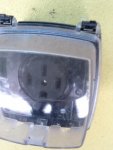Im working on a office going into a existing strip mall with a centralized electric room. It is fairly vital for this office to have power during a power outage, and they originally wanted a back-up generator for all their computers, phone & AC etc. After visiting the site, and speaking with the landlord, they said it is impossible to install a generator on the site, and the municipality would not allow them to do so.
The adjacent tenant discovered this early while the building was being built and had a 240V receptacle added so he could bring in a portable generator, plug it in to that receptacle which I took a picture of (See attached).
If I put a few lights, receptacles and but no AC on a separate sub-panel and fed it with a manual transfer, would I be able to power the transfer switch with the 240V receptacle and the generator? Is a set-up like this legal?
The adjacent tenant discovered this early while the building was being built and had a 240V receptacle added so he could bring in a portable generator, plug it in to that receptacle which I took a picture of (See attached).
If I put a few lights, receptacles and but no AC on a separate sub-panel and fed it with a manual transfer, would I be able to power the transfer switch with the 240V receptacle and the generator? Is a set-up like this legal?

